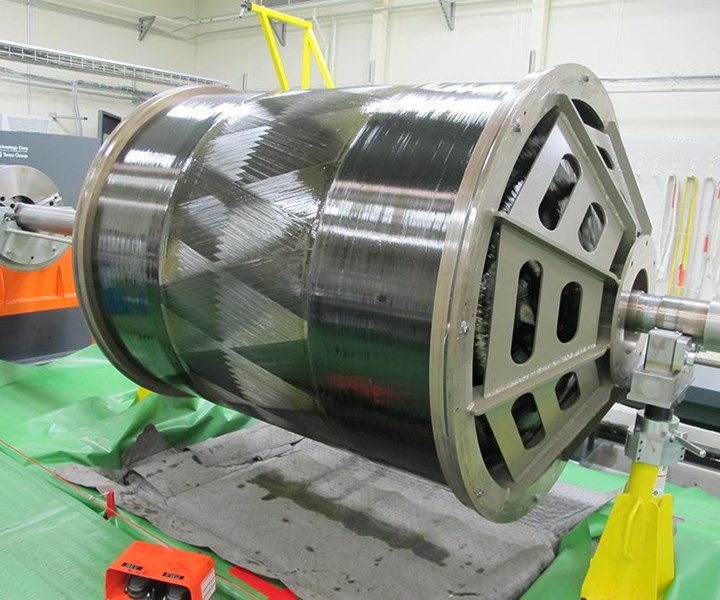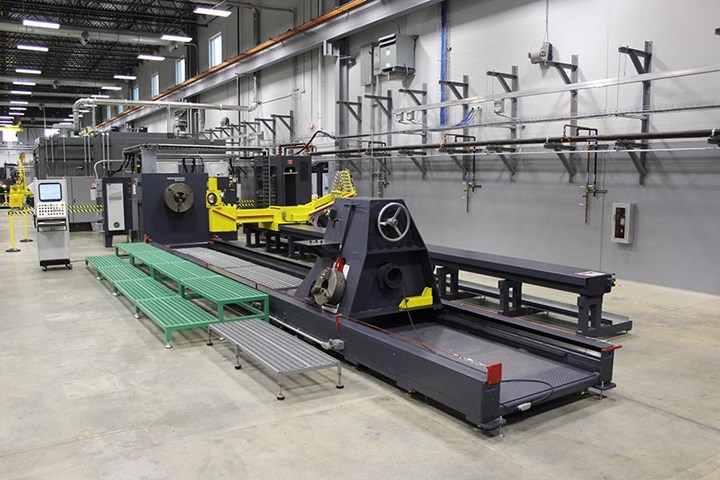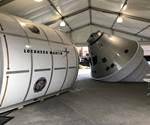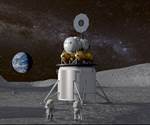Aerojet Rocketdyne to provide propulsion for Orion spacecraft fleet
In a recent contract with Lockheed Martin, Aerojet Rocketdyne engines and other products will be used on NASA’s Orion spacecraft for three Artemis missions.

An example of the type of large solid motor carbon fiber case Aerojet Rocketdyne will produce at its new Huntsville, Alabama, Advanced Manufacturing Facility starting in early 2020. Source | Aerojet Rocketdyne
Aerojet Rocketdyne (Sacramento, Calif., U.S.) was recently awarded a contract by Lockheed Martin (Littleton, Colo., U.S.) to support production of NASA’s Orion spacecraft fleet for Artemis missions three through five, with an option to support missions six through eight with three additional shipsets.
The contract for three shipsets of propulsion elements will be managed and performed out of the company’s facility in Redmond, Washington. Work will also be conducted at Aerojet Rocketdyne facilities in Huntsville, Alabama, and Orange County, Virginia.

This motor carbon fiber-winding machine will begin producing large solid rocket motor cases in Huntsville, Alabama, starting in early 2020. Source | Aerojet Rocketdyne
According to the company, Orion’s propulsion system includes the following Aerojet Rocketdyne products:
- Orion Main Engine: Mounted on the spacecraft’s European Service Module (ESM), the 6,000-pound thrust main engine will provide the primary propulsion for Orion’s major in-space maneuvers. Aerojet Rocketdyne is refurbishing the bipropellant orbital maneuvering engine’s valves in support of NASA’s effort to reuse engines from the space shuttle program.
- Auxiliary Engines: Also mounted on the ESM, eight 110-pound thrust bipropellant engines based on the flight-proven R-4D engine family, will maintain Orion’s in-space trajectory and position. They also will provide backup to the main engine.
- Launch Abort System (LAS) Jettison Motor: The jettison motor provides approximately 40,000 pounds of thrust to separate the LAS from the crew module in the event of a launch anomaly, enabling the spacecraft and crew to safely land with parachute assistance. The motor also fires during a nominal mission, separating the LAS from the spacecraft, to enable the crewmembers to continue on their journey.
- Reaction Control System (RCS): The RCS is comprised of 12 160-pound-thrust MR-104J monopropellant thrusters mounted in 10 pod assemblies. At the conclusion of Artemis missions, the Crew Module will separate from the ESM prior to re-entering Earth’s atmosphere. After this point, Aerojet Rocketdyne’s RCS thrusters are the sole means for controlling the spacecraft’s orientation during atmospheric reentry and altering its course in preparation for splashdown.
“We have been a part of every crewed mission launched from U.S. soil and are very proud to continue supporting the future of human space exploration,” says Ken Young, general manager of Aerojet Rocketdyne’s Redmond operations.
Related Content
-
Novel dry tape for liquid molded composites
MTorres seeks to enable next-gen aircraft and open new markets for composites with low-cost, high-permeability tapes and versatile, high-speed production lines.
-
Plant tour: Joby Aviation, Marina, Calif., U.S.
As the advanced air mobility market begins to take shape, market leader Joby Aviation works to industrialize composites manufacturing for its first-generation, composites-intensive, all-electric air taxi.
-
Plant tour: Spirit AeroSystems, Belfast, Northern Ireland, U.K.
Purpose-built facility employs resin transfer infusion (RTI) and assembly technology to manufacture today’s composite A220 wings, and prepares for future new programs and production ramp-ups.

.jpg;width=70;height=70;mode=crop)













.jpg;maxWidth=300;quality=90)
